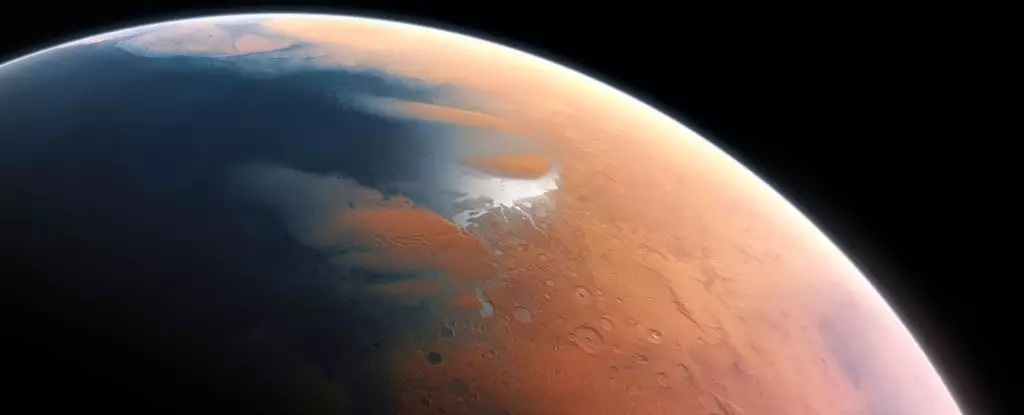Mars, often referred to as the Red Planet, presents a paradox between its current desolation and its past as a potentially vibrant world teeming with water. Recent findings suggest that far from being the dusty, dry terrain we observe today, Mars once boasted vast oceans, supported by substantial geological evidence. This radical perspective transforms our understanding of the planet and raises compelling questions about the history of water, climate, and potential life on Mars.
In a groundbreaking study utilizing ground-penetrating radar, scientists have revealed structures beneath the Martian surface that mirror ancient beaches and river deltas, indicative of a time when Mars hosted a significant body of water approximately four billion years ago. This research has led to the identification of a previously unknown sea dubbed Deuteronilus, affirming the theory that Mars could have harbored a northern sea—a finding that redefines our perception of the planet’s geological history. Geologist Benjamin Cardenas from The Pennsylvania State University emphasized the breadth of their discovery, stating they found evidence consistent with a beach environment, revealing an extraordinary past where wind and waves shaped the landscape.
Interestingly, while Mars’s surface is now largely dry and uninviting, the evidence suggests a more aqueous past filled with expansive bodies of water that once flowed freely and shaped the terrain. The dust storms and barren landscapes of today’s Mars mask a dynamic history of hydrological processes that have left their mark on its geology.
Reevaluating Mars’ Water History
The mystery of Mars’s water history remains a complex puzzle. While it is increasingly clear that liquid water was once abundant, key questions still linger: What was the volume of water, how long did it persist, and how did it evaporate? These inquiries keep researchers captivated as they sift through evidence that suggests oceans played a pivotal role in shaping not just the surface, but potentially the climate as well.
Geophysicist Michael Manga emphasizes the fundamental importance of oceans on planetary climates and surfaces, stating that they significantly influence everything from climate systems to potential habitability. As the scientific community gravitates towards the mantra of “follow the water” in Mars exploration, the research team attempts to piece together the timeline and fate of this essential resource.
Recent advances in technology have opened new pathways for exploration. The Chinese National Space Administration’s (CNSA) Zhurong Mars rover has played a critical role in this investigation, using ground-penetrating radar to delve deep beneath the surface of Mars. This technology has effectively created a 3D map of the subsurface, unveiling thick sedimentary layers that exhibit characteristics akin to those found along Earth’s shorelines.
The evidence reveals not only the presence of sand-like deposits but also architectural features consistent with ancient coastlines, characterized by their orientation and sloping angles toward the presumed shorelines—akin to how Earth’s beaches are structured. This discovery implies a significant interaction between liquid water, sediment deposition, and environmental forces, suggesting that Mars enjoyed a long-term water cycle akin to that of Earth’s oceans.
The Implications of Past Oceans for Life
The tantalizing prospect that Mars could have supported life hinges significantly on these ancient aquatic environments. Coastal zones are considered prime candidates for habitability; these areas provide a confluence of water, land, and atmospheric conditions conducive to life as we understand it. This foundation invites further examination of where and when these environments existed, guiding future exploratory missions aimed at detecting signs of life.
Manga and his team’s findings shed light on where to direct future research efforts, particularly in regions previously posited as likely havens for early life. Given that Earth’s earliest life forms likely emerged in similar coastal settings, these sites on Mars may harbor analogous beginnings for alien organisms.
Recent theories propose that much of Mars’ water may still exist, albeit trapped in the planet’s interior as liquid reservoirs—pristine remnants of the once-thriving Martian hydrosphere. The current state of research demands that scientists rigorously test the hypothesis of ancient oceans, understanding their potential velocities and tidal patterns while comparing them to Earth’s water dynamics.
As researchers continue to unravel the mysteries of Martian hydrology, these findings herald an exciting chapter in not only our understanding of Mars but also the broader quest to ascertain whether life ever existed beyond Earth. With each discovery, we inch closer to determining the enigmatic history of water on Mars and the implications it may have for astrobiology and planetary exploration.


Leave a Reply